SOLAR APPRECIATION DAY
By Alyssa Jairam

1.0 SUMMARY
Solar Appreciation Day is celebrated annually on the second Friday of March and recognizes the importance and benefits of Solar Energy. This day allows us to recognize the role of solar energy as a sustainable form of energy to meet the energy demands of the present and future generations. In addition, solar energy can reduce our dependence on fossil fuels for electricity generation which will aid in combating Climate Change. This research paper focuses on understanding solar energy with the aim of educating persons on solar energy and its associated applications and benefits. The paper covers harnessing solar energy using solar panels, solar projects that are being developed in Trinidad and Tobago, and global statistics regarding solar power production. It also discusses the major ways whereby solar energy is harnessed, and the benefits associated with solar energy. The paper concludes with various ways whereby persons can maximize the use of solar energy in their everyday lives.
2.0 INTRODUCTION TO SOLAR ENERGY
The Sun can be described as a hot, glowing ball of Hydrogen and Helium which is located at the center of our solar system. The Sun is the oldest star of about 4.6 billion years old and lies approximately 150 million kilometers from our planet Earth (NASA, 2023). The temperature at the surface of the Sun is around 10,000 Fahrenheit (5,600°C) while the core, which is the hottest part of the Sun, can reach 27,000,000 Fahrenheit or 15,000,000°C (Cool Cosmos, 2023).
A process called Nuclear Fusion allows the Sun to shine by fusing two Hydrogen atoms into one Helium atom within the core. This fusion process generates energy in the form of heat and light and is called Solar Energy. The Sun is capable of converting 5 million tons of mass into energy per second which not only heats the Sun but also allows the Sun to radiate heat to Earth and other planets (Cool Cosmos, 2023). Solar energy is a renewable resource and refers to any type of energy that is generated by the Sun and can be harnessed directly or indirectly for human use.
At present, the global human population is approximately 8.1 billion (Worldometer, 2023) and is expected to increase to 9.7 billion by 2050 (United Nations, 2023). As such, the increase in global human population results in the increased need for electricity for meeting human demands. Hence, the topic of Solar Energy was chosen as this form of renewable energy is sustainable and can meet the needs of both the present and future generations. Additionally, Solar Energy can be obtained almost anywhere on Earth and solar technologies are scalable which permits application on a small-scale for powering a single household or on a large-scale for industrial or commercial use. Solar Energy is therefore capable of meeting our energy demands while decreasing our present and future dependence on fossil fuels and by reducing environmental impacts associated with the traditional power generation method using fossil fuels.
3.0 PAPER OBJECTIVES
The aims of this paper are:
- To understand what is meant by the terms ‘Solar Energy’ and ‘Photovoltaic Effect.’
- To educate persons on how solar panels function to generate electricity.
- To bring awareness of the two (2) Solar Park projects currently being developed in T&T.
- To understand the mains ways of harnessing solar energy.
- To educate persons on the benefits of solar energy and
- To show how to maximize the use of solar energy in their everyday lives.
4.0 APPLICATION OF THEORY
4.1 Solar Panels
The Photovoltaic Effect was discovered by Edmond Becquerel in 1839 whereby electricity is generated from direct sunlight (Chu, 2023). In order to generate solar energy, solar panels which use the photovoltaic effect are used. These are often mounted on rooftops of houses and buildings such as businesses, schools and even hospitals so that the Sun’s energy can be harvested and converted into electricity for use in these buildings (Turgeon, 2023).
A solar panel or Photovoltaic (PV) panel is a piece of equipment that converts sunlight into electricity via several solar cells known as PV cells. The first solar cell was invented in 1883 by Charles Fritts by coating sheets of selenium with a thin layer of gold however, the electrical efficiency was only about 1% which was not every practical (American Physical Society, 2023). This discovery, however, gave rise to the solar panel with which we are familiar today.
Solar panels are usually made from silicon or another semi-conductor material that is installed in a metal frame with a glass casing so that when the material is exposed to photons of sunlight which are small packets of energy, electrons will be released to produce an electric charge. This PV charge produces an electric current in the form of Direct Current (DC) which is then converted to Alternating Current (AC) via an inverter (National Gird, 2023). This Alternating Current (AC) is what we use in our daily lives to power household appliances such as refrigerators, air conditioners, water heaters, fans, televisions, lighting etc. (Refer to Figure 1).
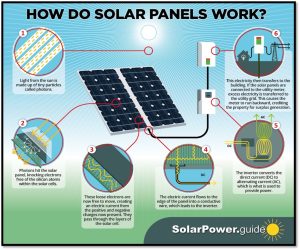
Figure 1: Six steps involved in the functioning of a solar panel. Source: SolarPower.Guide
4.2.0 Solar Projects in Trinidad and Tobago
At present, there are two (2) solar energy projects in progress in Trinidad and Tobago which are the Orange Grove Solar Farm and the Solar Park Project at the Piarco International Airport.
4.2.1 Orange Grove
The Orange Grove area is an estate in Trinidad and Tobago that is 4,000 acres and is located nearby to the village of Caroni and the suburb of Trincity. The Orange Grove Solar Farm is being developed by the Government of the Republic of Trinidad and Tobago together with BP and Shell. The project includes a 20MW solar farm on educational farmland that is leased from the state by the University of the West Indies (UWI) and a grid connection line to the existing T&TEC Orange Grove Sub-station and Piarco Sub-station. The proposed site of the solar farm is a 60ha agricultural plot that is immediately west of the Churchill Roosevelt Highway and Trincity Mall (Refer to Figure 2).
This Orange Grove Solar Farm project includes seven (7) stages which are as follows:
- Site Selection
- Preliminary Assessments and Site Design
- Planning Application
- Discharge of Planning Conditions
- Construction
- Operation
- Decommissioning
Currently, steps 1 to 4 have been completed and the Orange Grove Solar Farm is undergoing the construction phase which lies at stage 5.
The solar farm is expected to be operational in the third quarter of 2024 and is projected to generate energy equivalent to the energy needs of 7,000 households (Lightsource BP, 2023).
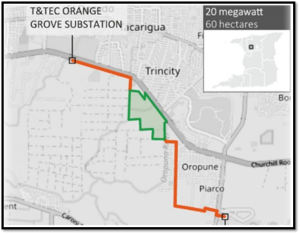
Figure 2: Location of the Orange Grove Solar Farm in Trinidad and Tobago. Source: Energy Now TT
4.2.2 Solar Park Project Piarco International Airport
The second project is the construction of a Solar Park at the Piarco International Airport, which is located 30km east of Downtown Port-of-Spain, in the suburban town of Piarco. The solar park will consist of ground-mounted solar panels that are installed over an area of 1.54ha with an annual generation capacity of 1,443,830KWh which is projected to represent 7.1% of the total electricity consumed at the airport. Additionally, the construction of this solar project aims at reducing yearly carbon dioxide emissions by 1,010 metric tonnes and to decrease Trinidad and Tobago’s overall carbon footprint (Ministry of Planning and Development Trinidad and Tobago, 2023).

Figure 3: A worker preparing the land for installation of the ground-mounted solar panels at the Piarco Solar Park.
Source: Ministry of Planning and Development
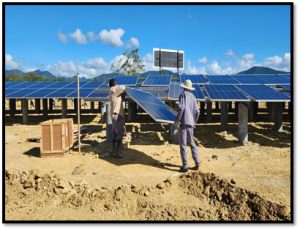
Figure 4: Workers installing ground-mounted solar panels at the Piarco Solar Park for electricity generation at the Piarco International Airport.
Source: Loop Trinidad and Tobago News
5.0 GLOBAL STATISTICS
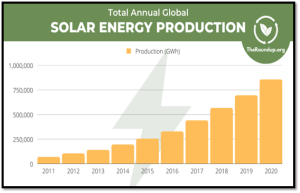
Figure 5: The total global production of solar energy annually for the period 2011-2020. Source: TheRoundup.org
As seen on Figure 5 above, the total annual global production of solar energy shows a steady increase from 2011 to 2020. In the year 2020, the total amount of solar energy produced globally was approximately 856, 000 GWh which is more than ten times greater than the amount of solar energy generated in 2011 which was about 62,500 GWh. This statistic was chosen because it shows that as time progresses and energy demands increase, the production of energy also increases. However, the production of energy is being conducted using renewable energy sources instead of the traditional fossil fuels. Also, from 2011 to 2020, there is a trend of increased energy production using solar which illustrates that Solar Energy is becoming the more popular and common method for power generation worldwide.
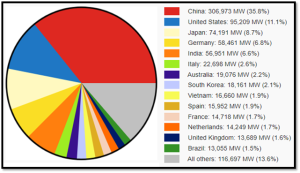
Figure 6: Countries and associated cumulative solar PV capacity in 2011. Source: IRENA
As seen on Figure 6 above, China had the highest solar power capacity worldwide in 2021 of 306,973 MW which account for 35.8% of their total energy generated followed by the US and Japan with 95,209 MW (11.1%) and 74,191 MW (8.7%) respectively. This statistic was chosen as it ranks countries based on their respective solar PV capacity which shows that globally, countries are resorting to alternative ways for generating power to meet their energy demands. Since energy from the sun is limitless, the use of solar energy provides countries with the ability of meeting their power generation goals. In 2011, Trinidad and Tobago had a solar power capacity of 2.57 MW and is ranked in the category of ‘All Others’ which accounts for 13.6%.
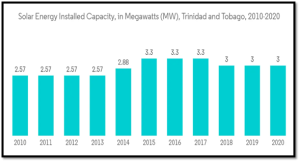
Figure 7: Solar energy installed capacity in Trinidad and Tobago for the period 2010-2020. Source: Mordor Intelligence
As seen on Figure 7 above, the installed capacity of solar energy in Trinidad and Tobago remained stagnant between 2-3 MW since 2010 due to the lack of investments by foreign and domestic companies regarding the country’s renewable energy sector which hindered the development of utility-sized solar projects locally. However, solar energy projects have been conducted on a small-scale with two 2-kilowatt (kW) off-grid PV systems in operation at the University of Trinidad and Tobago (UTT) and T&TEC’s Mt. Hope compound. Twenty-one 1-kW PV systems were also installed at schools throughout Trinidad and Tobago until 2020.
6.0 DISCUSSION
6.1.0 Main Ways to Harness Solar Energy
The three (3) main ways whereby solar energy can be harnessed are as follows:
- Photovoltaics (PV) – This refers to the generation of electricity directly from sunlight by using the photovoltaic process. This allows us to power small electronic devices such as calculators and road signs as well as homes and large commercial businesses or buildings (Solar Energy Industries Association, 2023).
- Solar Heating and Cooling (SHC) – This involves the collection of thermal energy from the sun and uses this heat to provide hot water, heating of a room, cooling and even heating of a pool for residential, commercial or industrial applications. SHC technologies replace the need for the use of electricity or Natural Gas (Solar Energy Industries Association, 2023).
- Concentrating Solar Power (CSP) – This involves generating electricity by converting the Sun’s energy in order to power a turbine. However, CSP technologies can also be used to deliver heat to various industrial applications such as enhanced oil recovery, water desalination, chemical production, mineral processing and food processing activities (Energy Efficiency and Renewable Energy, nd.).
6.1.1 Benefits of Solar Energy
Solar Energy is sustainable and inexhaustible, meaning that, it cannot be depleted as the energy source, which is the Sun, does not need to be replenished. By increasing the use of solar energy, less dependence will be placed on fossil fuels.
Some benefits associated with solar energy are as follows:
- Solar energy reduces the impact on the environment as it does not produce greenhouse gases nor pollute water. Solar energy is therefore a clean energy source that does not generate carbon emissions or other greenhouse gases that trap heat in the atmosphere. Solar energy also avoids environmental damage since activities like mining or drilling for fossil fuels are not required to generate electricity.
- Solar energy allows you to save on your electricity bill since generating your own electricity by using solar lights or a solar water heater in your home, means that you will be using less electricity from the utility provider. Additionally, if you produce an abundance of electricity from your solar system, you can sell the unused electricity by generating it back to the grid. According to the Trinidad and Tobago Financial Act No.13, incentives are in place for Tax Credit for Solar Water Heaters. In particular, individuals who purchase solar water heating equipment for household use are entitled to a tax credit of 25% of the cost of the equipment up to a maximum of TT$10,000 with a maximum tax credit of TT $2,500 (Ministry of Energy and Energy Industries, 2023).
- Solar energy is applicable almost everywhere as long as there is sunlight. This therefore allows solar energy systems to be deployed in remote regions that lack other sources of electricity. Apart from powering homes and businesses, solar energy can also be used to power boats, ships and even spacecrafts.
- Solar energy provides employment since persons are needed in the design process, to manufacture the various components of solar panels as well as in the installation and maintenance of solar panels. A typical solar panel has a lifespan of 25-30 years with proper maintenance hence, there is a wide range of job opportunities involved with solar energy generation.
6.1.2 Maximizing Solar Energy Utilization
The use of solar energy can be used to meet most, if not all, of the energy needs in one’s household. Individuals can participate in the following to maximize the use of solar energy in his/her home:
- Install solar powered ventilation fans for large rooms to reduce cooling costs.
- Invest in a solar water heater.
- Use photoelectric panel systems when your electronic devices require charging. For example, many simple and inexpensive solar panel kits have connections that allow you to plug in your cellphone, tablet or laptop for direct charging.
- Invest in solar powered landscape or outdoor lighting to brighten up your lawn or driveway.
- Install solar panels on your rooftop to power lights for a portion of your home.
- When hosting parties or events, utilize solar party lights which come in different designs and colors. This will not only result in the beautification of your party/event but also save you money on your electric bill.
- Invest in a solar oven or solar cooker for preparing meals. You can also create your own DIY solar oven at home to reheat leftover Pizza or to bake cookies.
- Hang washed clothes out on a line in the sun for drying instead of using an electric dryer.
7.0 CONCLUSION
Solar energy involves the capturing of heat and light from the Sun through the use of solar panels which contain solar cells that are used to generate electricity for powering homes, businesses, schools and hospitals. Globally, during the period 2011 to present, there has been an increase in the production and use of solar energy with China having the highest solar power capacity worldwide of 306,973 MW in 2021. Since 2010, Trinidad and Tobago has been stagnant between 2-3 MW however, there have been small-scale solar projects throughout the island. Presently, there are two large-scale solar projects underway which are the Orange Grove Solar Farm (20 MW) and the Solar Park at the Piarco International Airport that aims to generate 1, 443, 830 kWh annually. The harnessing of solar energy can be achieved through PV (Photovoltaic) systems, SHC (Solar Heating and Cooling) systems and CSP (Concentrating Solar Power) systems. Finally, there are various benefits associated with solar energy and numerous ways whereby individuals can maximize solar energy utilization in homes, businesses and public spaces.
References
- “A Short History of Solar Panels.” 2023. Retrieved from Mr.Solar.com: https://www.mrsolar.com/what-is-a-solar-panel/
- Chodos, Alan. 2023. “The First Practical Silicon Solar Cell.” Retrieved from American Physical Society (APS): https://www.aps.org/publications/apsnews/200904/physicshistory.cfm
- Chu, E. and L. Tarazano. 2023. “A Brief History of Solar Panels.” Retrieved from Smithsonian Magazine: https://www.smithsonianmag.com/sponsored/brief-history-solar-panels-180972006/
- “Concentrating Solar-Thermal Power.” n.d. Retrieved from Energy Efficiency and Renewable Energy: https://www.energy.gov/eere/solar/concentrating-solar-thermal-power
- “Current World Population.” 2023. Retrieved from Worldometers: https://www.worldometers.info/world-population/
- “How Do Solar Panels Work?” 2023. Retrieved from Solar Power Guide: https://solarpower.guide/solar-energy-insights/how-do-solar-panels-work
- “How Exactly Is Electricity from Solar Energy Produced?” 2023. Retrieved from National Grid: https://www.nationalgrid.com/stories/energy-explained/how-does-solar-power-work
- “Orange Grove Solar Farm.” 2023. Retrieved from Lightsource BP: https://lightsourcebp.com/tt/project/orange-grove-solar-farm/
- “Renewable Capacity Statistics.” 2022. Retrieved from International Renewable Energy Agency: https://www.irena.org/-/media/Files/IRENA/Agency/Publication/2022/Apr/IRENA_RE_ Capacity_Statistics_2022.pdf
- “Renewable Energy and Energy Efficiency Fiscal Incentives.” 2023. Retrieved from Ministry of Energy and Energy Industries, Trinidad and Tobago: https://www.energy.gov.tt/our-business/alternative-energy/renewable-energy-and-energy-efficiency-fiscal-incentives/
- “Renewable Energy Projects in Trinidad and Tobago.” 2020. Retrieved from Energy Chamber of Trinidad & Tobago: https://energynow.tt/blog/lightsource-reveals-details-about-the-renewable-energy-projects-in-tampt
- Ruiz, Arabella. 2023. Retrieved from The Round Up: https://theroundup.org/solar-power-statistics/
- “Solar Energy.” 2023. Retrieved from Solar Energy Industries Association: https://www.seia.org/initiatives/about-solar-energy
- “Solar Park Makes Progress at Piarco International Airport.” 2023. Retrieved from Ministry of Planning and Development, Trinidad and Tobago: https://www.planning.gov.tt/content/solar-park-makes-progress-piarco-international-airport
- “Sun.” 2023. Retrieved from NASA: https://solarsystem.nasa.gov/solar-system/sun/overview/
- “The Advantages and Disadvantages of Solar Energy.” 2023. Retrieved from Constellation: https://www.constellation.com/energy-101/energy-innovation/solar-energy-pros-and-cons.html
- “The World in 2100.” 2023. Retrieved from United Nations (UN): https://www.un.org/en/global-issues/population
- “Trinidad and Tobago Solar Energy Market Size and Share Analysis – Growth Trends and Forecasts (2023-2028). 2023. Retrieved from Mordor Intelligence: https://www.mordorintelligence.com/industry-reports/trinidad-tobago-solar-energy-market
- Turgeon, A. and M. Elizabeth. 2023. “Solar Energy.” Retrieved from National Geographic: https://education.nationalgeographic.org/resource/solar-energy/
